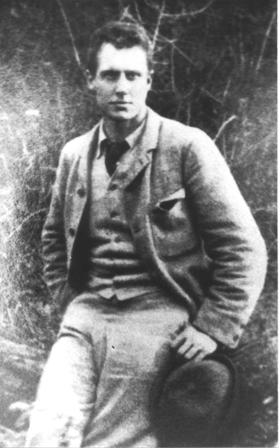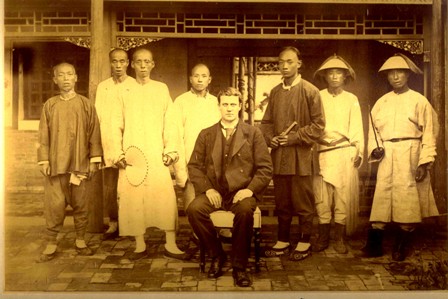 Wiki.jpg)
Dr George Ernest Morrison.
See Also
Pott' Reminiscences of Dr George Ernest MorrisonRead more in the December 2021 Ad Astra article
'An Australian in China'.
Dr George Ernest Morrison, journalist, doctor and traveller, and known internationally as ‘Chinese’ Morrison, was the eldest son of the founding Principal, George Morrison. Only a select few students from the School have achieved international fame but of these the first who can be said to have attained world-wide reputation is Dr George Ernest Morrison.
Born at the now demolished Knowle House, shortly after the foundation of the School, he became a student of the College from 1870 to 1878. He played in both the College First Football and Cricket Teams in 1877 and 1878 and, in his final year at the School won the College Cup in 1878. He matriculated in 1877.

Goerge Ernest Morrison.
On leaving school, he entered the University of Melbourne to study medicine, and it was then that his wandering proclivities first began to display themselves. In 1880, he walked through isolated country, much of which had not been settled along the southern coasts of Victoria and South Australia from Geelong to Adelaide. The following year he canoed down the Murray from Wodonga to the mouth and walked back to Geelong. In 1882, he shipped as an ordinary seaman on the vessel Lavinia, writing a series of investigative articles published in the Melbourne
Age newspaper which revealed the exploitation of Pacific islanders recruited for employment in Queensland. He then continued his nomadic pedestrian career by walking back to Geelong from Normanton on the Gulf of Carpentaria, roughly tracking the route of Burke and Wills. Although several of his previous walking accounts had been published, it was the series of articles on ‘kanaka’ recruitment, and the controversy that followed his critical letter on the subject to the
Age after his return to Geelong, that were to establish his career as a journalist. Sent by the
Age to explore New Guinea he was severely wounded and retreated ignominiously back to Australia. After convalescence, Morrison left for Edinburgh to complete his medical studies. It was here that surgeons finally removed the New Guinea spearhead that was buried in his abdomen.
Despite his graduation in 1887 he chose not to settle down, and set off round the world again. He visited North America, West Indies, Spain, Morocco and Paris, and then returned to Australia for two years as resident surgeon at the Ballarat Hospital. In 1893, he set out for the East again, where he was to make a second reputation. His first exploit was to travel overland from Shanghai to Rangoon in 1894 - a distance of about 4,880 kms on foot. He then returned to London and published his well received account of this adventure. Appointed by the
Times newspaper as their special correspondent, he returned to Thailand, eventually transferring to Beijing where he was to become the most renowned western commentator on Chinese affairs for the next twenty-two years. Between 1897 and 1912, he explored China from end to end. He is said to have visited every province except Tibet, and on one occasion (in 1910), he completed the longest journey of his career, journeying from Port Hunan across Asia to Russian Turkestan – a distance of some 6,000kms in 175 days.

George Ernest Morrison with Chinese Group
In August, 1912, at South Croydon, Surrey, he married a New Zealander from Reefton on the West Coast, Jean Wark Robin (1889-1923). Three sons, Ian Ernest (1913-1950); Alistair (1915-2009) and Colin (1917-1990), were born between 1913 and 1917 in Beijing. The eldest, Ian, followed his father’s footsteps as a 'Times' journalist but was killed during the Korean War.
In 1912, Morrison was appointed by the Chinese President as a government advisor. He had played a prominent reporting role for many years, had first reported the 1898 Russian ultimatum to China and in 1900 described in detail the ‘Boxer’ rebellion and its aftermath. The Japanese war with Russia and the rise of Japanese power were of particular interest to him during this period. As an advisor, he assisted the Chinese in their negotiations at Versailles at the end of World War I but, battling illness, returned to England shortly afterwards.
Pegasus in its 1920 obituary of Morrison described his last days:
'The duties of this difficult and responsible position he entered into with the utmost enthusiasm — an enthusiasm which was maintained even after his last fatal illness had come upon him. To quote the London Times: — It was a strange experience to hear the dying man planning for the future with a skill of analysis, a breadth of vision in constructive statesmanship, and altogether a mental vigour such as one associates with only a few men in the world and these in the enjoyment of bodily health. It was then one realised how inadequate to the breadth of the man was even the proud title 'Morrison of Peking.' Morrison died at Sidmouth, Devon in 1920. His young wife Jean died, not many years after, in 1923.
The following was noted in
Pegasus of August 1915:
‘The President of China has conferred upon Dr G E Morrison the right to wear the insignia of the First Class Order of the Excellent Crop. What this means exactly, we do not know; but it sounds as though the Doctor has now reached the summit of earthly ambitions.’ The extensive papers and records of G E Morrison are held in the Mitchell Library, Sydney. A bronze plaque to his memory and funded by Old Collegians’ was installed in the old Main Entrance to the School.
George Ernest Morrison was inducted into the Old Geelong Collegians' Association (OGCA) Notables Gallery at Geelong College in 2011.
Sources: Pegasus May 1918 pp 23-27; Pegasus August 1920 pp 17,18; Pegasus 1915; Pegasus December 1965 pp 55-58; G E Morrison, An Australian in China; Cyril Pearl, 'Morrison of Peking'; J S Gregory, 'Morrison, George Ernest (Chinese) (1862-1920)', Australian Dictionary of Biography, Volume 10, Melbourne University Press, 1986, pp 593-596; 'Old China through G E Morrison's eyes' compiled by Shen Jiawei NSW State Lib, 2006; P Thompson & R Macklin 'The Man who Died Twice'. Allen & Unwin.